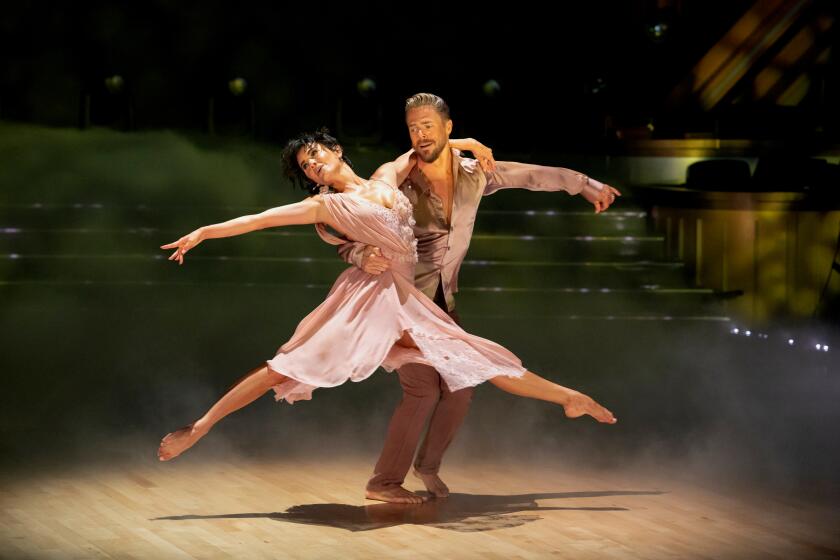âThe Electronic Groveâ : Video Art Takes the Viewer Into the Picture
PITTSBURGH â Avant-garde artists armed with video cameras rather than paint brushes are creating electronic works of art designed to draw the viewer into the picture.
âPeople are captivated by this art form,â said video artist Mary Lucier. âIt screens out distractions. It draws you into a completely new and different world. In that sense, itâs kind of like going to the movies.â
A new exhibit, âAmerican Landscape Video: The Electronic Grove,â features work done in the past decade by seven leading video artists, including Lucier.
The exhibits, on display through July 10 at Pittsburghâs Carnegie Museum of Art, feature bright moving images that appear on video monitors illuminating darkened rooms.
The videotapes show waves crashing against icebergs as birds call, a green palm rustling in the wind and a forest fire raging amid crackles and pops. Eerie music plays as the camera peers up the face of a gray cliff and then focuses on rippling water.
The artists placed rocks, trees and other objects around the video monitors, which have screens up to 25 inches wide. In one work, viewers can turn away from the screens and see their own images in the still water of a reflecting pool. In another, a coil periodically emits a deafening electrical charge that prompts adults to cover their ears and schoolchildren to scream.
âEach space creates its own environment,â Lucier said. âThe impact, I think, is greater than sculpture. There is the sound as well as moving images and three-dimensional objects.â
Many people resist the concept of video art, assuming viewing it would be like watching television, but they usually like the works once they see them, said Bill Judson, film curator at the Carnegie.
âPeople come in and they see this and they say, âMy God, I love that,â â he said. âTheyâre astonished in themselves.â
Video art began in the mid-1960s, when advances in technology made black-and-white film equipment more affordable. In the early â70s, museums began showing elaborate video displays, and some artists used color computer-generated images in their work.
In New York, the Metropolitan Museum of Art and the Whitney Museum of American Art have displayed video works, but many smaller museums canât afford the cost of building the exhibits, Judson said.
âThereâs a lot of great work being done, but itâs just not getting exposure,â he said.
In Lucierâs âWilderness,â three videotapes are shown simultaneously on seven monitors placed on white pedestals. She filmed the same sites depicted by such 19th-Century American landscape artists as Thomas Cole and Frederic Church, showing gleaming icebergs against a backdrop of clear sky.
One work, âRoom for St. John on the Cross,â has a gyrating image of mountaintops projected on a large screen. In the center of the room is a small cube with light streaming from a single window. A voice reciting in Spanish can be heard, and a white-capped mountain is shown on a small video monitor inside the cube.
Artist Bill Viola said the work is based on a Spanish mystic who wrote love poetry and dreamed of flying over mountains despite being confined and tortured for nine months in a cell.
Doug Hallâs âThe Terrible Uncertainty of the Thing Describedâ features six monitors and a large screen that show a roaring fire, tornadoes whirling and storms at sea. Within the gallery, a steel fence encloses the coil that fires an electrical discharge at two oversized, stainless steel high-backed chairs.
In âThe Allure of the Concentricâ by Rita Myers, four monitors amid large volcanic rocks show close-up views of leaves and weeds, dry cracked ground and the silhouette of stark tree trunks against sky.
Frank Gillette placed eight eye-level monitors in a square, showing reeds in a marsh, birds flying and other wildlife in the wilderness north of Corpus Christi, Tex.
Around the corner, the viewer stands in the center of a ring of eight monitors showing natural and colorized images that Steina Vasulka created of New Mexican mountains and the desert.
In Dara Birnbaumâs âWill-oâ-the Wisp,â three monitors placed in a panel show a woman amid trees as a womanâs voice speaks about a former lover.
More to Read
The biggest entertainment stories
Get our big stories about Hollywood, film, television, music, arts, culture and more right in your inbox as soon as they publish.
You may occasionally receive promotional content from the Los Angeles Times.










